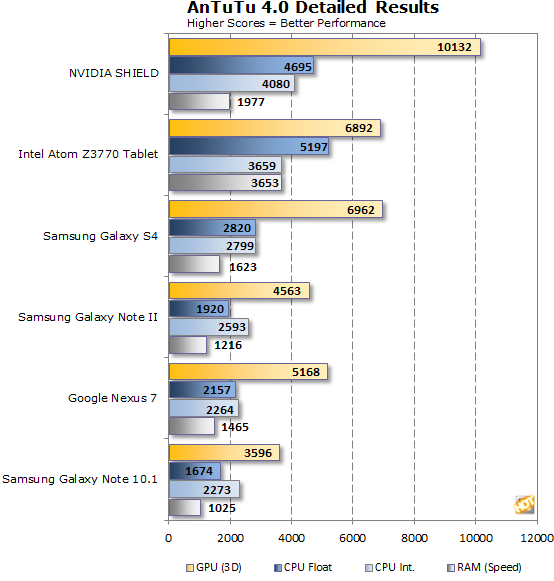Betting On Bay Trail: Intel's Atom Overhaul Tested
|
Bay Trail's performance in Android was rougher in spots than we saw with Windows, but there are more devices to test against here and a tougher operating environment overall. After W8's weak launch, all the momentum in the tablet industry is currently focused on Android-based designs and this is where Bay Trail will have to cut its teeth as well. However, you can of course also expect the WIntel alliance to be strong with next generation Windows 8.1 tablets flowing freely from various OEMs.
We'll start with AnTuTu 4.0, which we recommend taking with a grain of salt. While this isn't the version of the program that caused a furor earlier this summer when it was found to be erroneously handing Clover Trail an easy victory, this version of the benchmark doesn't appear to have been validated independently.

AnTuTu's performance puts Bay Trail ahead of everything but NVIDAI's Shield. Shield, it should be noted, is something of an unusual device. While it runs Android and is designed as a tablet alternative, it has a fan+heatsink. It's got the most aggressive cooling of any device on this list, which means it can clock substantially higher than many of its counterparts. Here, we see the Shield's GPU outstrip all others, with the Z3770 and the Galaxy S4 - itself no slouch - tying for second place. The Z3770 leads the S4 in integer and floating point performance and its memory is significantly faster.
Browsermark:

Browsermark is another strong show for the Z3770. Chrome is somewhat faster than the default Android browser, but the 3770 is faster than Shield, which beats out the other hardware on the list. The gap is significant given that Shield has active cooling, and every other device (including Bay Trail), doesn't.
MobileXPRT:
MobileXPRT is an Android benchmark that measures performance in five performance scenarios -- applying photo effects, creating photo collages, slideshows, encrypting data, and facial detection. In the chart below, the top line is the total score, while the individual tests are listed in time-to-complete. Higher scores are better in the Overall Score, while lower scores represent faster times to complete the tests in the detail below it.

What we see here, again, is that SHIELD (NVIDIA's Tegra 4 SoC) and the Intel Atom Z3770 are very closely tied, with other Android devices lagging by a significant margin.
SunSpider 0.9.1:
Sunspider 0.9.1 is the signature Javascript benchmark that we've run for
a number of years. It's a single-threaded test where Intel CPUs have
traditionally excelled.

That definitely continues to be the case here, where SunSpider performance breaks the 600ms mark. As a side note, two years ago, seeing Medfield run these tests in ~1300ms using Gingerbread was a major coup for Intel then. Now, single-thread performance is running more than twice as fast, though part of that is definitely due to optimizations from Google. Even the relatively pokey HTC One and Galaxy Note 10.1 are faster than the Medfield reference platform we saw at the end of 2011.
Finally, some 3D benchmarks on Android: GLBench and 3DMark.
GLBenchmark:

We used GLBenchmark's Egypt off-screen test to ensure an equal playing field for every device. Here, the Z3770 SoC puts in respectable, though not top-of-the-line figures. 41 FPS is enough to tie Google's excellent Nexus 7, while the iPad 4 (Apple A6X) and SHIELD (Tegra 4) are both significantly faster, at 54 FPS and 56 FPS respectively.
3DMark Ice Storm:
In the newer 3DMark benchmark Ice Storm, we measured framerates in both of the two game tests. Here, the Z3770 is slower than most of the competition in "Unlimited" mode, but actually loses far less performance in "Extreme." This suggests that Intel's Android drivers need additional tweaking. Still, based on what we've seen in Android, it's fair to say that the CPU/GPU complex is very competitive with what we've got from any other vendor, beating out all but the actively-cooled SHIELD.


Intel's GPU is under more competitive pressure from companies with longer histories in this market. Still, Intel has always played this as a long-term game. Medfield, Clover Trail, and Clover Trail+ were all designed as products that could compete well at the midrange with Bay Trail aimed at taking competition to a higher level. Based on what we've seen, the company has succeeded.
Now let's talk Windows.






